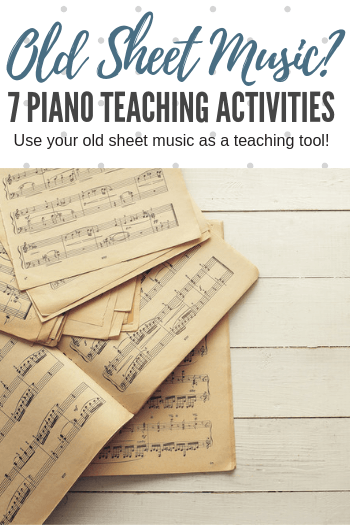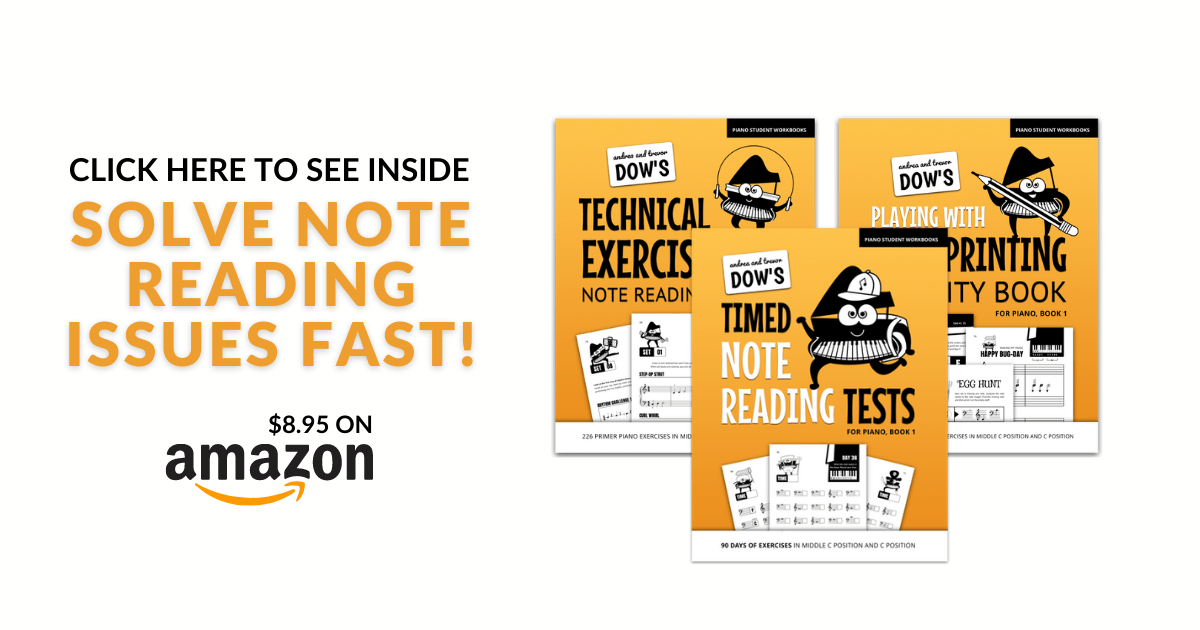I’m sure, like me, you have stacks of old piano books “gifted” to you by friends and relatives cleaning out their attics. My own collection is filled with everything from Readers Digest’s “Treasury of Best Loved Songs” to Country and Western hits from the ’40s.
I know I likely will never use these music books, but I simply cannot bear to recycle or throw away sheet music!
Recently, I sat down to come up with some ways to repurpose these old tunes. And while Pinterest is full of crafty sorts of ideas that require vats of mod podge (and vats of patience) I decided to stay away from the crafty approach and instead attempt to figure out how I could use this retired music as a teaching tool.
After a little brainstorming, I came up with 7 ways to breathe new life into old sheet music… and turn our piano kids into sight-reading superstars at the same time!

7 Ways To Repurpose Old Sheet Music Into Sight- Reading Fun
- Colorful Note Reading: Cut out one line from any old music book and tape it to a blank sheet of paper. Draw a “legend” on the paper using a variety of marks. For example: red = G, green = D, yellow = B. Instruct your students to use the “key” to identify and color the corresponding notes in the line of music.
- Chord Progression Identification: Give your students a red pen and a page of music from an old book. Have them identify the primary chords of the key in which the music is written and then label the I, IV, and V chords in the piece, circling the chord tones found within each measure.
- Composition Starters: Cut out a few measures from the first line of music from an old book and paste it on the top of blank staff paper. Have your students sight-read the snippet. Next help them use the musical ideas from the measures (melodic choices, rhythm, motives, etc) to create a “mini-composition” that acts as a short continuation from the measures they were given that is completely their own.
- Rock Around the Clock: Cut out 12 one-measure snippets from a piece of old music. Write the time signature and key signature at the top of the page (as some measures will be missing this information). Tape the measures in a circle on a blank piece of paper – labeling them 1 through 12 (like a clock face). Call out each number (working your way around the clock in order). As you call out each number, have your students sight-read the corresponding measure. Can your students “rock around the clock” without making a mistake?
- Create a Lead Sheet: Cut out a line of music from an old book and then cut it into two halves, keeping only the treble clef line. Paste the treble clef line to a piece of paper. Next, help your students turn it into a lead sheet; discover the chords that “fit” with each measure and write the corresponding chord symbol on top of the staff. Create various LH accompaniments for the new lead sheet allowing your students to experiment with various rhythmic patterns.
- Guess the Time Signature: Cut out three lines of music from different piano pieces. Cut off any measures that contain the time signature. Hand each line of music to your students one at a time. Have them attempt to guess the time signature of each piece.
- The Great Piano Piece Puzzle: Cut out four consecutive measures from a single piece so that you have four one-measure chunks. Place the chunks in the correct order on the music stand. Have your students sight-read the chunks in their correct order. Next, mix the measures up so that they are out of order and place them back in a row on the music stand. Can your students put the four measures back into the correct order?


Brilliant Andrea – we all have stacks of old music which we can’t bear to part with, so here’s a great way to use it.
Hi Fionagh – glad you enjoyed the post! Would love to hear how you like the activities once you use them 🙂
Thank you! Particularly in this past year, I’ve been given SO much old music. I, too, hate to throw it away. These ideas are great. I’d love to continue hearing more ideas, because I have a LOT of old music!! Even craft, etc. ideas would be great. A few years ago, I used old music to make ornaments for each of my students — http://girlsinwhitedressesblog.com/2014/12/12/musical-christmas-ornaments/
Hi Susan – I’m sure we all own way more boxes of music than we could ever, ever use but yes, it feels wrong to throw it away doesn’t it! Love the craft idea – I’ll try that next year maybe! 🙂
What a creative way to use old music! I love your ideas and can’t wait to use them with my students. Thank you so much. 🙂
Thanks for reading our blog Linda! Glad you found the post inspiring 🙂
Great ideas for those boxes of old music at our studio. When we get there today I’m going to try out some of these ideas. THANKS!
This is timely as my old boss (from 13 years ago!) stopped by my house yesterday with a big box full of old music! I worked at an adult day care center for people with Alzheimer’s and dementia and we did music about three times a week. These are great ideas!
Also, I would absolutely love to see a video of you teaching a full lesson! I still struggle to see how so much can fit into thirty minutes. I’d love to see you in action!
I second the idea of a video of Andrea teaching an entire lesson! Different lessons at different levels would be way cool, too.
Hi Diane! My “trick” is to not try to cram everything into one lesson every single time. I blogged about my approach here: https://www.teachpianotoday.com/2014/08/27/30-minutes-of-shock-and-awe-the-piano-teacher-trap-youll-want-to-avoid/
Those are great ideas, thanks! I think I’ll try some of that prep on my ‘holidays’.
You have to put holidays in ” ” don’t you.. piano teachers don’t really take a complete break 😉 Thanks for reading Laura!
Love these ideas! Thank you, thank you!
thanks for these ideas-I have a ton of old music and, like you, can’t throw it out. I also have books from 2 teachers who retired this fall and gave away a whole lot of books. These ideas are fabulous!
Fantastic! Love it when the timing is “just right” – have fun Yvonne and thanks for commenting!
This is genius! Thanks for the great ideas. I actually love receiving old sheet music — I welcome boxes from garages, estates of older relatives, etc. First I play through everything, and — gasp — recycle everything I don’t want. Then I put the rest in my ‘old sheet music’ cupboard and get them out and play them once or twice a year. I have sheet music from the 1890’s through the 1950’s — and I even love the musty smell it has, from sitting in people’s garages and attics. But now I know what to do with the rejects. Thanks so much for sharing this!
I know the exact smell you mean – and I love it too. Reminds me of my Grandma’s piano bench 🙂 Thanks for reading our blog Kathy!
Love these ideas! On a side note, if you don’t want any of your old Reader’s Digest books, I’ll take them. I love them and so do my students, lol. 😉
Great ideas! Kids will love working with old music. They’re always attracted to them when they see it on the shelves! Thanks for sharing your creative ideas =)
These are AWESOME ideas.
These are the best ideas! I can even adapt them to use with my newest beginning students. Thank you!!
I will be breaking out my old and unused music immediately! Why didn’t I think of any of these ideas? Thank you so much. 🙂
I love you for this!!!
Such great ideas for repurposing old sheet music! Can’t wait to try these with my students. I’m really enjoying all the articles on your site…you provide such wonderful ideas! Thank you!
Thanks for reading our blog Sarah! 🙂 Glad you’re finding it enjoyable!
I’ve been using old books by letting the students rip out a sheet, add chords or extra melody notes. At Group lessons we will have 2 or 3 students play their songs at the same time (with same key/Time signature) and hear the beauty!